
If you grow tomatoes, you've probably come across a tomato or tobacco hornworm or two. I've come across many, many, many hornworms over the years, and trust me, once you've met a hornworm you don't forget it.
Hornworms are big - they measure 4 inches long when fully grown. < YIKES!! > And they are usually pretty fat too, probably due to their eating every single stinking tomato leaf and stem they can get into the mouths of their huge, walrus-like heads.
And, as if that weren't enough, they also have a "horn" coming out of their rear end (hence their name).
I'm painting a pretty picture, aren't I?
But, they are actually beautiful in their own strange, caterpillar creepy crawlie way. They have markings on their sides that look like eyes (called Spiracles), 5 prolegs (in the back), and 3 thoracic legs (in the front). And, their heads ... well, I'm not really sure how to describe their heads. Their heads are just plain strange.
See .... pretty, huh?

Tobacco Hornworms vs. Tomato Hornworms
Both tobacco hornworms and tomato hornworms are found throughout the US. Tobacco hornworms (Manduca sexta) tend to be more prevalent in the south and tomato hornworms (Manduca quinquemaculata) more prevalent in the north. Although very similar in size and appearance, the tobacco hornworm has a red horn and stripes on it's sides, where the tomato hornworm has a blue or black horn and V shaped markings on it's sides.
I've only ever seen tobacco hornworms in my Virginia gardens and all of the photos here are of tobacco hornworms I've encountered.
Hornworms eat tomato plants and other members of the Solanaceae family
They are incredibly destructive to any plant they decide to eat. Hornworms feed mainly on tomato and tobacco plants, but also on potatoes and eggplants. They can defoliate a lush tomato plant in a single night. I'm not kidding! You'll walk out to check on your prized tomato plant one morning and will be dumbfounded to see that it was reduced to a pile of sticks and stems overnight. If a large hornworm is on it, it can be gone quickly.
G-O-N-E.
And you'll cry.
Then you'll get mad and realize that you need to find the culprit asap because he's moved on to the next plant and is working on reducing it to a pile of sticks and stems right now too. And when he's done with that one, he'll move to the next... You'd better find him, and quick!
So, how do you spot a hornworm on your tomato (or other) plants?
You have to check your plants on a daily basis (sometimes I check mine a few times throughout the day). You need to really inspect them and look closely for any telltale signs of hornworms.
I primarily find signs of hornworms in one of two ways:
- I'll spot some missing leaves or some leafless stems poking out where they shouldn't be. Then I'll spend what seems like an eternity looking over the plant in an attempt to find the little bugger. Finding a hornworm on a tomato plant can be more frustrating and more difficult than finding Waldo in a Where's Waldo book. (If only hornworms wore little red hats....which they don't by the way). Hornworms are very well camouflaged and you can look right at them repeatedly and not see them. Look long and hard. Look again and then again. Don't give up. Follow along the branches of the plant and especially along the trail of missing leaves and you'll probably find the hornworm. Eventually.
OR - I'll spot the poo. This is a much easier method of tracking down a hornworm. Where there is poo, there is (or was) a critter. Hornworm poo is pretty large (well, large for a caterpillar anyway) and looks like a little grenade. You can't miss it and once you spot it, you can be sure there's a hornworm in the vicinity. Just look around/above where the poo is and you'll likely find the hornworm.
I spotted this poo just yesterday on one of my potato plants ....
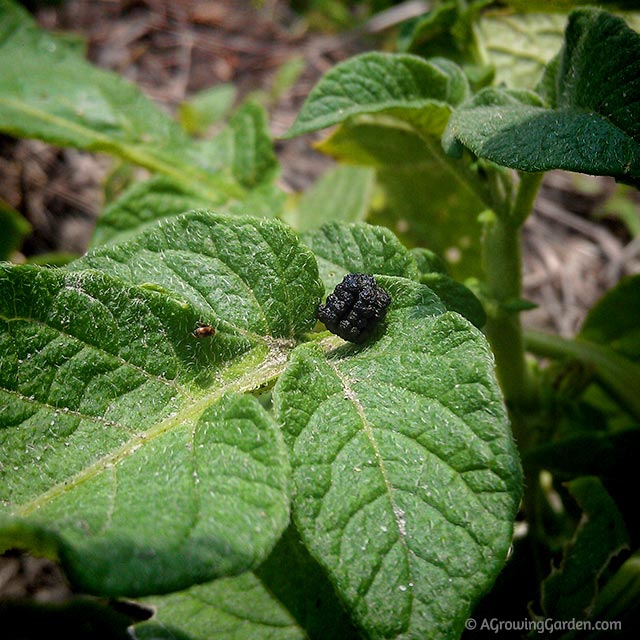
And happily munching away a few branches up, I found this ....

See how he'd already eaten many of the leaves and stems? He wasn't yet fully grown and was about 2 inches long. If I hadn't noticed him or had left him there (I didn't!), he probably would have eaten the entire potato plant.
What can you do to prevent hornworms from destroying your garden?
Hornworms overwinter in the ground, so if you till your garden early each spring, you should be able to kill any overwintering pupae which can help for any early summer problems.
For home gardens, you should be able to patrol your plants and pull off and kill any hornworms you find. Like I said, I patrol the plants at least once a day. Some days I am amazed at how many hornworms I'll find.
Hornworms also have some natural enemies that can help control the population too. The Braconid Wasp is a great help in controlling hornworms. It will lay it's eggs under the skin of the hornworm. When the eggs hatch, the larvae feed on the flesh of the hornworm and eventually chew their way out. When the offspring emerge from the hornworm, they then spin cocoons and pupate on the back of the hornworm. Eventually the hornworm will die and the emerging wasps will continue the cycle.
A hornworm that has been attacked by the Braconid Wasp is easy to spot. If you see a hornworm with what looks like a bunch of white eggs on it's back, leave it alone! It won't do any more damage to your plants and the wasps will emerge to help you with other hornworms!
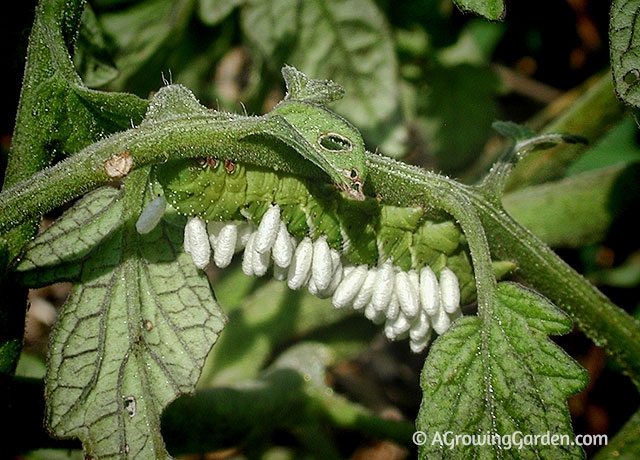
I have to admit that when I see a hornworm with wasp cocoons on it's back, I kind of feel sorry for it. Seems like an awful way to die... but the cycle of nature goes on.
Have you ever come across a tomato or tobacco hornworm?





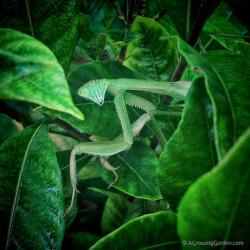
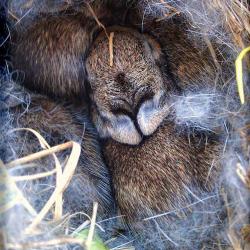
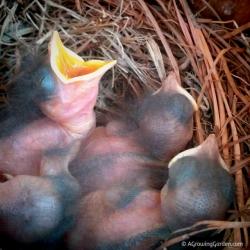
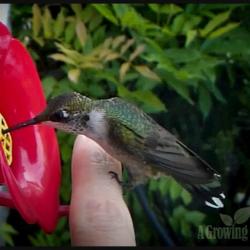



Join the Conversation!
Horticultural Zone: 6
June 19, 2013
EEW!
Reply